Vertical Spatial Differentiation and Influencing Factors of Rural Livelihood Resilience: Evidence from the Mountainous Areas of Southwest China
Abstract
:1. Introduction
2. Materials and Methods
2.1. Study Area and Samples
2.2. Methods
2.2.1. Sample Classification Based on Terrain Gradients
- Low mountain areas (0.39 < RDLS ≤ 1.71). Distributed in Southern Yunnan, Northern Sichuan and Eastern Guizhou and Chongqing, totaling 112 counties, accounting for 47.86% of the area.
- Medium mountain areas (1.72 < RDLS ≤ 3.10). Distributed in Western Yunnan, as well as the junction area of Yunnan–Guizhou–Sichuan, totaling 82 counties, accounting for 31.05% of the area.
- High mountain areas (3.11 < RDLS < 4.69). Concentrated in Western Sichuan and Northeastern Yunnan, totaling 40 counties, accounting for 35.45% of the area.
2.2.2. Rural Livelihood Resilience Evaluation
2.2.3. Influencing Factors Analysis
- (1)
- Factor detector. Factor detector is employed to assess the explanatory power of a single factor on the dependent variable. The explanatory power of each factor is quantified by q-value:where q is explanatory power of factor (X) on RLR (Y) change, h is the number of discretized classifications of factor (X) or RLR (Y), Nh and N are the number of units for classification h and the whole region, respectively, and σh2 and σh are the variance of RLR (Y) for the units in classification h and the whole region, respectively. The range of q-values is [0, 1], and the larger the q-value, the stronger the explanatory power of factor (X) on RLR (Y) change. The significance level of q-value is determined through the noncentral F-test.
- (2)
- Interaction detector. Interaction detector is used to detect whether the explanatory power under the influence of two factors is enhanced, weakened or independent of each other by comparing the single factor q-values (q(Xn) and q(Xm)) and interaction q-values (q(Xn∩Xm)).
2.3. Date Source
3. Results
3.1. Overall RLR Evolution
3.2. RLR Presentation in Different Terrain Gradients
3.3. Influencing Factors of RLR
4. Discussion
4.1. Evolution and Vertical Spatial Differentiation of RLR
4.2. Key Influencing Factors of RLR
4.3. Policy Implications
- Extending the agricultural industry chain to promote efficient rural socioeconomic development. Agriculture is the pillar industry in rural areas, and farmers are the main labor force in agriculture; therefore, upgrading the RLR should be based on agricultural development [44]. In low mountain areas, especially typical karst areas, large-scale and professional animal husbandry (livestock and poultry) should be developed in villages unsuitable for planting; in medium mountain areas, the modern planting industry (e.g., vegetables, tea, flowers, fruits, walnuts, coffee and edible fungi) can be advanced by virtue of the unique low-latitude plateau climate in small mountain basins; in high mountain areas, cold-hardy cash crops (e.g., Chinese herbs, barley, potatoes and rapeseed) and specialty animal husbandry (e.g., yaks, Tibetan pigs and Tibetan chickens) should be encouraged to be planted and farmed in combination with forest and grassland conservation. Based on agricultural development, secondary and tertiary industries such as organic food processing, agricultural product circulation, rural tourism and agricultural insurance should be developed to promote the efficient integration of the primary, secondary and tertiary industries and improve industrial diversity [20,69]. Industrial and commercial capital should also be strongly supported to enter rural industries.
- Improving rural production and living infrastructure. Increase the financial investment and social capital to encourage rural infrastructure construction and compensate for deficiencies in transportation and logistics, agricultural water conservation, information networks and basic energy in mountainous rural areas [18,27,38]. In low mountain areas, the emphasis should be placed on developing all-encompassing programs to prevent rocky desertification, fortifying rural and agricultural water supply systems, utilizing advanced technology to construct multipurpose methane digesters and enhancing rural logistics and transportation systems; in medium mountain areas, efforts should be made to upgrade the level of agricultural machinery and equipment, increase the degree of automation and the technological content of agriculture and build high-standard farmland; in high mountain areas, the focus should be on improving the standard of rural roads and firmly pushing the all-encompassing project to enhance the rural environment. Relocating rural households to locations with better natural conditions and infrastructure is necessary when it comes to highly unfriendly rural areas.
- Enhancing the supply of high-quality social public services. It is necessary to establish a fair and sustainable public service system, so that farmers can enjoy more reliable social security; better quality education; higher levels of medical care; more employment opportunities and stronger rural disaster prevention, mitigation and relief capabilities [4,17,45]. In low and medium mountain areas, it is recommended that reliance be placed on grassroots autonomous organizations to organize regular knowledge and skills training by industry employment needs and to export the labor force from villages with a larger population in an organized manner. In high mountain areas, it is essential to maintain a high standard of medical and healthcare provision. Furthermore, the introduction of family doctor services should be considered.
5. Conclusions
- From 2000 to 2020, the RLR in the mountainous areas of Southwest China has improved significantly, with the average value of the RLR index growing from 0.131 to 0.427; however, its level is still low. The RLR structure has consistently demonstrated a primary pattern of “buffering capability > adjustment capability > renewal capability”. The renewal capability is much lower than the buffer and adjustment capabilities, which has become a barrier to the high-quality development of RLR.
- RLR in the mountainous areas of Southwest China does not show a strict negative correlation with the terrain gradients. This is, to some extent, a deviation from the general law that socioeconomic development is significantly negatively correlated with terrain gradients. The RLR in high mountain areas is lower than that in medium and low mountain areas; however, there are no significant gaps in the RLR and various capabilities between low and medium mountain areas. Even the RLR and capacities in medium mountains are outpacing those in low mountains with rapid growth. The reasons for this phenomenon can be reasonably explained by the unique geographical and resource endowments and the actual socioeconomic development of these areas.
- RLR heterogeneity is the result of the coupling of multiple factors. The geographical environment is becoming less significant, industrial diversity and social public services are becoming more significant and the economic foundation has always been a key driving force of RLR. Economic development, non-agricultural industries and grassroots autonomous organizations are the essential determinants for RLR. Economic development, grassroots autonomous organizations and transportation conditions are more important in low and medium mountain areas, while non-agricultural industries and medical conditions contribute more to high mountainous areas.
- To enhance the RLR and fully tap into the risk resistance potential of rural livelihood systems, local governments can focus their policies on extending the agricultural industry chain to integrate the primary, secondary and tertiary industries effectively and promoting efficient rural socioeconomic development; improving rural production and living infrastructure and compensating for deficiencies in transportation, agricultural water conservation, information networks and basic energy in mountainous rural areas and enhancing the supply of high-quality social public services and establishing a fair and sustainable social public service system.
Author Contributions
Funding
Institutional Review Board Statement
Informed Consent Statement
Data Availability Statement
Conflicts of Interest
References
- Biggs, E.M.; Bruce, E.; Boruff, B.; Duncan, J.M.A.; Horsley, J.; Pauli, N.; McNeill, K.; Neef, A.; Van Ogtrop, F.; Curnow, J.; et al. Sustainable development and the water-energy-food nexus: A perspective on livelihoods. Environ. Sci. Policy 2015, 54, 389–397. [Google Scholar] [CrossRef]
- Long, H.L.; Ma, L.; Zhang, Y.N.; Qu, L.L. Multifunctional rural development in China: Pattern, process and mechanism. Habitat Int. 2022, 121, 102530. [Google Scholar] [CrossRef]
- Chen, C.; Woods, M.; Chen, J.L.; Liu, Y.Q.; Gao, J.L. Globalization, state intervention, local action and rural locality reconstitution—A case study from rural China. Habitat Int. 2019, 93, 102052. [Google Scholar] [CrossRef]
- Su, F.; Luo, J.Q.; Zhu, X.Q.; Tong, L.; Zheng, Y.Y.; Xie, Y.J. Study on Measurement and Influencing Factors of Livelihood Resilience in Rural Areas of Hubei Province. Adv. Earth Sci. 2021, 36, 1117–1126. [Google Scholar]
- Li, Y.H. A systematic review of rural resilience. China Agric. Econ. Rev. 2023, 15, 66–77. [Google Scholar] [CrossRef]
- Manyena, S.B. The concept of resilience revisited. Disasters 2006, 30, 433–450. [Google Scholar] [CrossRef]
- Holling, C.S. Resilience and stability of ecological systems. Annu. Rev. Ecol. Syst. 1973, 4, 1–23. [Google Scholar] [CrossRef]
- Wu, J.; Wu, T. Ecological Resilience as a Foundation for Urban Design and Sustainability. Resil. Ecol. Urban Des. 2013, 3, 211–229. [Google Scholar]
- Chaffin, B.C.; Scown, M. Social-ecological resilience and geomorphic systems. Geomorphology 2018, 305, 221–230. [Google Scholar] [CrossRef]
- Wang, Z.X.; Wei, W. Regional economic resilience in China: Measurement and determinants. Reg. Stud. 2021, 55, 1228–1239. [Google Scholar] [CrossRef]
- Gaillard, J.C. Vulnerability, capacity and resilience: Perspectives for climate and development policy. J. Int. Dev. 2010, 22, 218–232. [Google Scholar] [CrossRef]
- Fan, W.R.; Lv, W.Q.; Wang, Z.X. How to measure and enhance the resilience of energy systems? Sustain. Prod. Consum. 2023, 39, 191–202. [Google Scholar] [CrossRef]
- Cote, M.; Nightingale, A.J. Resilience thinking meets social theory: Situating social change in socio-ecological systems (SES) research. Prog. Hum. Geogr. 2011, 36, 475–489. [Google Scholar] [CrossRef]
- Marschke, M.J.; Berkes, F.E. Exploring strategies that build livelihood resilience: A case from Cambodia. Ecol. Soc. 2006, 11, 42. [Google Scholar] [CrossRef]
- Liu, W.; Li, J.; Ren, L.J.; Xu, J.; Li, C.; Li, S.Z. Exploring Livelihood Resilience and Its Impact on Livelihood Strategy in Rural China. Soc. Indic. Res. 2020, 150, 977–998. [Google Scholar] [CrossRef]
- Speranza, C.I.; Wiesmann, U.; Rist, S. An indicator framework for assessing Livelihood resilience in the context of social-ecological dynamics. Glob. Environ. Chang. 2014, 28, 109–119. [Google Scholar] [CrossRef]
- Li, T.; Cai, S.H.; Singh, R.K.; Cui, L.Z.; Fava, F.; Tang, L.; Xu, Z.H.; Li, C.J.; Cui, X.Y.; Du, J.Q.; et al. Livelihood resilience in pastoral communities: Methodological and field insights from Qinghai-Tibetan Plateau. Sci. Total Environ. 2022, 838, 155960. [Google Scholar] [CrossRef]
- Sun, Y.; Zhao, X.Y. Evolution of Livelihood Resilience and Its lnfluencing Factors of Out-of-Poverty Farmers in Longnan Mountainous Area. Sci. Geogr. Sin. 2022, 42, 2160–2169. [Google Scholar]
- Mavhura, E. Applying a systems-thinking approach to community resilience analysis using rural livelihoods: The case of Muzarabani district, Zimbabwe. Int. J. Disaster Risk Reduct. 2017, 25, 248–258. [Google Scholar] [CrossRef]
- Zhang, Y.; Xie, X.Y.; Qiu, X.P.; Jing, Z.; Yu, Y.Q.; Wang, Y. Study on Livelihood Resilience of Rural Residents under the Rural Revitalization Strategy in Ethnic Areas of Western Sichuan, China. Agriculture 2023, 13, 1957. [Google Scholar] [CrossRef]
- Li, H.B. Rural Settlements Research from the Perspective of Resilience Theory. Sci. Geogr. Sin. 2020, 40, 556–562. [Google Scholar]
- Fang, Y.P.; Zhu, F.B.A.; Qiu, X.P.; Zhao, S. Effects of natural disasters on livelihood resilience of rural residents in Sichuan. Habitat Int. 2018, 76, 19–28. [Google Scholar] [CrossRef]
- Nugraha, A.T.; Zahara, S.; Suhartini, W.; Zahid, U.; Hlahla, J. The Role of Social Capital on Community Resilience in Rural Areas:ACase Study in Ponggok Village, Indonesia. J. Reg. Rural Stud. 2024, 2, 1–14. [Google Scholar]
- Li, H.B.; Jin, X.B.; Liu, J.; Feng, D.Y.; Xu, W.Y.; Zhou, Y.K. Analytical framework for integrating resources, morphology, and function of rural system resilience-An empirical study of 386 villages. J. Clean. Prod. 2023, 365, 132738. [Google Scholar] [CrossRef]
- Zhao, X.; Xiang, H.X.; Zhao, F.F. Measurement and Spatial Differentiation of Farmers’ Livelihood Resilience Under the COVID-19 Epidemic Outbreak in Rural China. Soc. Indic. Res. 2023, 166, 239–267. [Google Scholar] [CrossRef]
- Geng, Y.W.; Li, X.S.; Chen, W.Q.; Liu, X.Z.; Chen, J.Q.; Ji, H.T. Identification of rural regional system resilience types and driving mechanism: Taking Suiyang District, Shangqiu City as an example. Prog. Geogr. 2023, 42, 1755–1768. [Google Scholar] [CrossRef]
- Ding, J.J.; Wang, Z.; Liu, Y.H.; Yu, F.W. Measurement of economic resilience of contiguous poverty-stricken areas in China and influencing factor analysis. Prog. Geogr. 2020, 39, 924–937. [Google Scholar] [CrossRef]
- Meybeck, M.; Green, P.; Vorosmarty, C. Comments: A New Typology for Mountains and Other Relief Classes: An Application to Global Continental Water Resources and Population Distribution. Mt. Res. Dev. 2001, 21, 34–45. [Google Scholar] [CrossRef]
- Zhang, J.J.; Zhu, W.B.; Zhu, L.Q.; Cui, Y.P.; He, S.S.; Ren, H. Topographical relief characteristics and its impact on population and economy: A case study of the mountainous area in western Henan, China. J. Geogr. Sci. 2019, 29, 598–612. [Google Scholar] [CrossRef]
- Milan, A.; Ho, R. Livelihood and migration patterns at different altitudes in the Central Highlands of Peru. Clim. Dev. 2014, 6, 69–76. [Google Scholar] [CrossRef]
- Feng, Z.M.; Tang, Y.; Yang, Y.Z.; Zhang, D. Relief degree of land surface and its influence on population distribution in China. J. Geogr. Sci. 2008, 18, 237–246. [Google Scholar] [CrossRef]
- Feng, Z.M.; Zhang, D.; Yang, Y.Z. Relief Degree of Land surface in China at County Level Based on Gls and Its Correlation between Population Density and Economic Development. Jilin Univ. J. Soc. Sci. Ed. 2011, 51, 146–151, 160. (In Chinese) [Google Scholar]
- Li, Y.H.; Huang, H.Q.; Wang, S.Y. Path of Urban-Rural Integrated Development in Traditional Agricultural Zones Based on Rural Economic Resilience: The Study of Typical Counties of Hebei Province. Econ. Geogr. 2021, 41, 28–33, 44. [Google Scholar]
- Cui, Z.Z.; Li, E.R.; Li, Y.H.; Deng, Q.Q.; Shahtahmassebi, A. The impact of poverty alleviation policies on rural economic resilience in impoverished areas: A case study of Lankao County, China. J. Rural Stud. 2023, 99, 92–106. [Google Scholar] [CrossRef]
- Zhou, J.; Chen, H.P.; Bai, Q.Y.; Liu, L.X.; Li, G.H.; Shen, Q.L. Can the Integration of Rural Industries Help Strengthen China’s Agricultural Economic Resilience? Agriculture 2023, 13, 1813. [Google Scholar] [CrossRef]
- Datola, G. Implementing urban resilience in urban planning: A comprehensive framework for urban resilience evaluation. Sustain. Cities Soc. 2023, 98, 104821. [Google Scholar] [CrossRef]
- Tang, D.C.; Li, J.N.; Zhao, Z.Q.; Boamah, V.; Lansana, D.D. The influence of industrial structure transformation on urban resilience based on 110 prefecture-level cities in the Yangtze River. Sustain. Cities Soc. 2023, 96, 104621. [Google Scholar] [CrossRef]
- Zhao, X.Y.; Chen, H.H.; Zhao, H.L.; Xue, B. Farmer households’ livelihood resilience in ecological-function areas: Case of the Yellow River water source area of China. Environ. Dev. Sustain. 2021, 24, 9665–9686. [Google Scholar] [CrossRef]
- DFID. Sustainable Livelihoods Guidance Sheets; Department for International Development: London, UK, 2000; pp. 68–125. [Google Scholar]
- Nasrnia, F.; Ashktorab, N. Sustainable livelihood framework-based assessment of drought resilience patterns of rural households of Bakhtegan Basin, Iran. Ecol. Indic. 2021, 128, 107817. [Google Scholar] [CrossRef]
- Fang, Y.; Fan, J.; Shen, M.; Song, M. Sensitivity of livelihood strategy to livelihood capital in mountain areas: Empirical analysis based on different settlements in the upper reaches of the Minjiang River, China. Ecol. Indic. 2014, 38, 225–235. [Google Scholar] [CrossRef]
- Yang, A.X.; Ye, J.Q.; Wang, Y.H. Coupling and Coordination Relationship between Livelihood Capital and Livelihood Stability of Farmers in Different Agricultural Regions. Land 2022, 11, 2049. [Google Scholar] [CrossRef]
- Kuang, F.; Jin, J.; He, R.; Ning, J.; Wan, X. Farmers’ livelihood risks, livelihood assets and adaptation strategies in Rugao City, China. J. Environ. Manag. 2020, 264, 110463. [Google Scholar] [CrossRef] [PubMed]
- Dang, X.; Gao, S.; Tao, R.; Liu, G.; Xia, Z.; Fan, L.; Bi, W. Do environmental conservation programs contribute to sustainable livelihoods? Evidence from China’s grain-for-green program in northern Shaanxi province. Sci. Total Environ. 2020, 719, 137436. [Google Scholar] [CrossRef] [PubMed]
- Zhu, S.J.; Sun, J.; Wu, Y.M.; Yu, B.H.; Li, H.; Xia, T.S.; Zhang, X.M.; Liang, X.Q.; Zhu, G.F. A rural revitalization model based on regional livelihood capital: A case study of Diqing, China. Front. Environ. Sci. 2023, 11, 1116742. [Google Scholar] [CrossRef]
- Awazi, N.P.; Quandt, A. Livelihood resilience to environmental changes in areas of Kenya and Cameroon: A comparative analysis. Clim. Chang. 2021, 165, 33. [Google Scholar] [CrossRef]
- Sarker, M.N.I.; Cao, Q.; Wu, M.; Hossin, M.A.; Alam, G.M.M.; Shouse, R.C. Vulnerability and Livelihood Resilience in the Face of Natural Disaster: A Critical Conceptual Review. Appl. Ecol. Environ. Res. 2019, 17, 12769–12785. [Google Scholar] [CrossRef]
- Wang, R.; Zhao, X.Y. Can Multiple Livelihood Interventions Improve Livelihood Resilience of Out-of-poverty Farmers in Mountain Areas? A Case Study of Longnan Mountain Area, China. Chin. Geogr. Sci. 2023, 33, 898–916. [Google Scholar] [CrossRef]
- Dong, Y.; Jin, G.; Deng, X.Z.; Wu, F. Multidimensional measurement of poverty and its spatio-temporal dynamics in China from the perspective of development geography. J. Geogr. Sci. 2021, 31, 130–148. [Google Scholar] [CrossRef]
- Zhao, J.C.; Ji, G.X.; Tian, Y.; Chen, Y.L.; Wang, Z. Environmental vulnerability assessment for mainland China based on entropy method. Ecol. Indic. 2018, 91, 410–422. [Google Scholar] [CrossRef]
- Su, F.M.; Li, P.Y.; He, X.D.; Elumalai, V. Set Pair Analysis in Earth and Environmental Sciences: Development, Challenges, and Future Prospects. Expo. Health 2020, 12, 343–354. [Google Scholar] [CrossRef]
- Tang, Z.P. Evaluation on Chinese provincial resource input and environmental output efficiencies from 2000 to 2015. Geogr. Res. 2018, 37, 1515–1527. [Google Scholar]
- Zhong, F.L.; Chen, R.B.; Luo, X.J.; Song, X.Y.; Ullah, A. Assessing regional resilience in China using a sustainable livelihoods approach: Indicators, influencing factors, and the relationship with economic performance. Ecol. Indic. 2024, 158, 111588. [Google Scholar] [CrossRef]
- Duan, Y.F.; Chen, S.P.; Zeng, Y.; Wang, X.T. Factors That Influence the Livelihood Resilience of Flood Control Project Resettlers: Evidence from the Lower Yellow River, China. Sustainability 2023, 15, 2671. [Google Scholar] [CrossRef]
- Wang, P.J.; Wang, J.; Zhu, C.B.; Li, Y.; Sun, W.J. Factors Influencing Livelihood Resilience of Households Resettled from Coal Mining Areas and Their Measurement—A Case Study of Huaibei City. Land 2024, 13, 13. [Google Scholar] [CrossRef]
- Wang, J.F.; Xu, C.D. Geodetector: Principle and prospective. Acta Geogr. Sin. 2017, 72, 116–134. [Google Scholar]
- Zhu, L.J.; Meng, J.J.; Zhu, L.K. Applying Geodetector to disentangle the contributions of natural and anthropogenic factors to NDVI variations in the middle reaches of the Heihe River Basin. Ecol. Indic. 2020, 117, 106545. [Google Scholar] [CrossRef]
- Liu, Y.S.; Guo, Y.Z.; Zhou, Y. Poverty alleviation in rural China: Policy changes, future challenges and policy implications. China Agric. Econ. Rev. 2018, 10, 241–259. [Google Scholar] [CrossRef]
- He, R.W.; Guo, S.L.; Deng, X.; Zhou, K. Influence of social capital on the livelihood strategies of farmers under China’s rural revitalization strategy in poor mountain areas: A case study of the Liangshan Yi autonomous prefecture. J. Mt. Sci. 2022, 19, 958–973. [Google Scholar] [CrossRef]
- Liu, Y.S.; Liu, J.L.; Zhou, Y. Spatio-temporal patterns of rural poverty in China and targeted poverty alleviation strategies. J. Rural Stud. 2017, 52, 66–75. [Google Scholar] [CrossRef]
- Yang, Z.; Hong, Y.; Guo, Q.B.; Yu, X.X.; Zhao, M.S. The Impact of Topographic Relief on Population and Economy in the Southern Anhui Mountainous Area, China. Sustainability 2022, 14, 14332. [Google Scholar] [CrossRef]
- Wu, Q.; Xiao, H.; Song, S.Z.; Li, Q.; Li, R.; Zhang, H.; Zhou, G.F.; Chen, H. Problems and Countermeasures of Agricultural Development in the Karst Area of Southwest China. Fresenius Environ. Bull. 2019, 28, 4247–4255. [Google Scholar]
- Li, H.; Liu, Y.F.; Zhao, R.; Zhang, X.F.; Zhang, Z.N. How Did the Risk of Poverty-Stricken Population Return to Poverty in the Karst Ecologically Fragile Areas Come into Being?-Evidence from China. Land 2022, 11, 1656. [Google Scholar] [CrossRef]
- Xu, J.; Zheng, L.J.; Ma, R.Q.; Tian, H. Correlation between Distribution of Rural Settlements and Topography in Plateau-Mountain Area: A Study of Yunnan Province, China. Sustainability 2023, 15, 3458. [Google Scholar] [CrossRef]
- Wang, Z.L.; E, S.X.; Du, T.; Zhang, L.Y.; Islam, M.; Li, J. Spatial distribution characteristics and influencing mechanism of rural settlements in mountainous areas. Trans. Chin. Soc. Agric. Eng. 2022, 38, 277–285. [Google Scholar]
- Qin, Y.; Luo, G.J.; Li, Y.B.; Tan, Q.; Zheng, C.; Yu, M.; Liao, J.J.; Li, M. Assessment of Sustainable Development of Rural Settlements in Mountainous Areas: A Case Study of the Miaoling Mountains in Southwestern China. Land 2022, 11, 1666. [Google Scholar] [CrossRef]
- Ranjan, R. How Socio-Economic and Natural Resource Inequality Impedes Entrepreneurial Ventures of Farmers in Rural India. Eur. J. Dev. Res. 2019, 31, 433–460. [Google Scholar] [CrossRef]
- Pandey, R.; Kumar, P.; Archie, M.K.; Gupt, A.K.; Joshi, P.K.; Valente, D.; Petrosillo, I. Climate change adaptation in the western-Himalayas: Household level perspectives on impacts and barriers. Ecol. Indic. 2018, 84, 27–37. [Google Scholar] [CrossRef]
- Zhou, W.F.; Guo, S.L.; Deng, X.; Xu, D.D. Livelihood resilience and strategies of rural residents of earthquake-threatened areas in Sichuan Province, China. Nat. Hazards 2021, 106, 255–275. [Google Scholar] [CrossRef] [PubMed]
- Zhu, J.G.; Sun, Y.R.; Song, Y.X. Household Livelihood Strategy Changes and Agricultural Diversification: A Correlation and Mechanism Analysis Based on Data from the China Family Panel. Land 2022, 11, 685. [Google Scholar] [CrossRef]
- Nguyen, S.V.; Dang, Q.N.; Ba, U.T.; Phuong, N.L.; Quang, N.N.; Minh, P.N.T.; Hoang, M.T.T. Tourism development affects on farmers household’s livelihood: Case study in Vietnam. Environ. Dev. Sustain. 2023, 25, 15163–15181. [Google Scholar] [CrossRef]
- Addinsall, C.; Weiler, B.; Scherrer, P.; Glencross, K. Agroecological tourism: Bridging conservation, food security and tourism goals to enhance smallholders’ livelihoods on South Pentecost, Vanuatu. J. Sustain. Tour. 2017, 25, 1100–1116. [Google Scholar] [CrossRef]
- Tang, W.Y.; Wang, Q.G.; Cheng, H.; Liu, T.H.; Wan, J.M. Livelihood vulnerability assessment of land-lost farmers in the context of tourism and the COVID-19 pandemic. Environ. Dev. Sustain. 2023. [Google Scholar] [CrossRef]
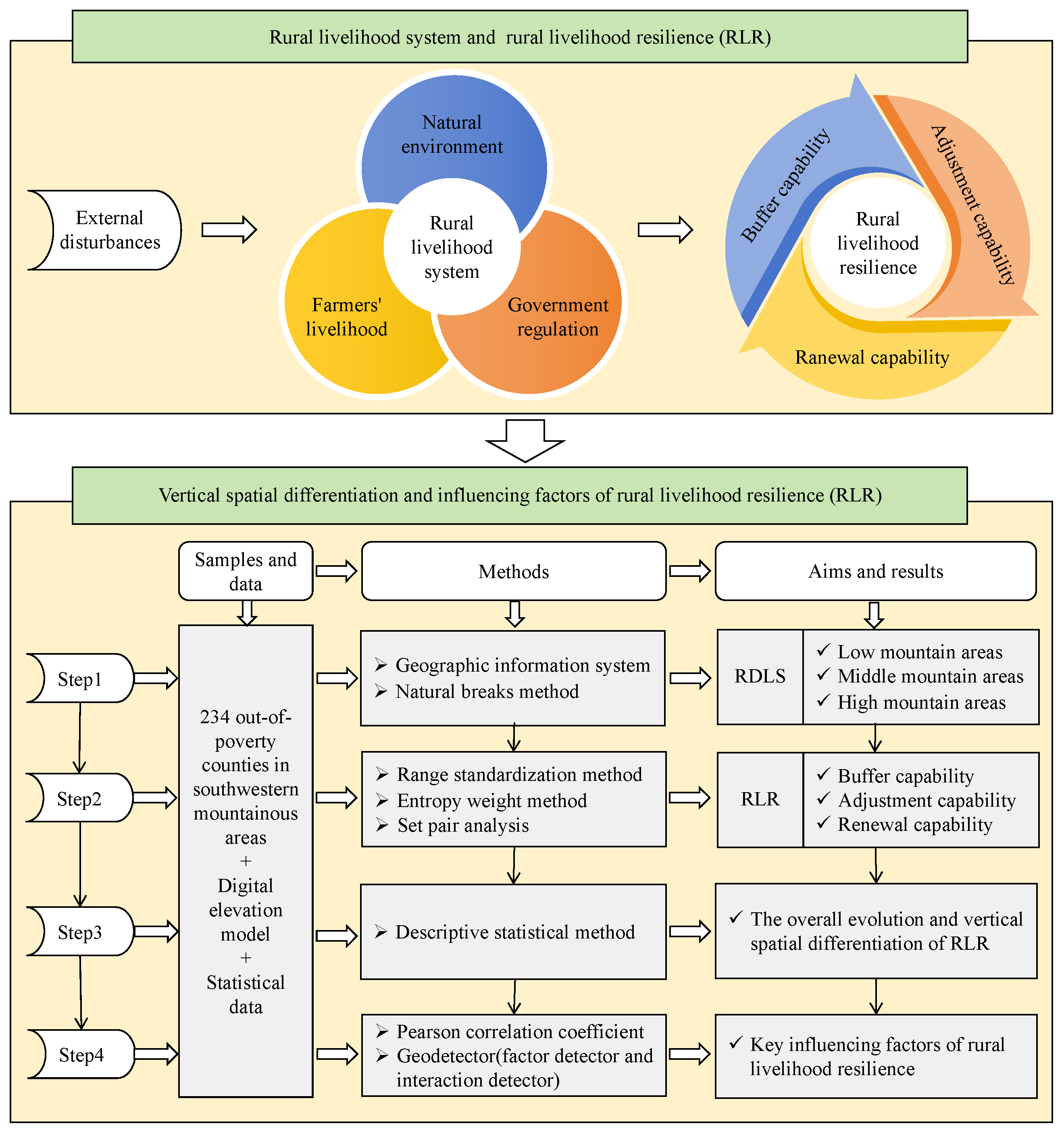

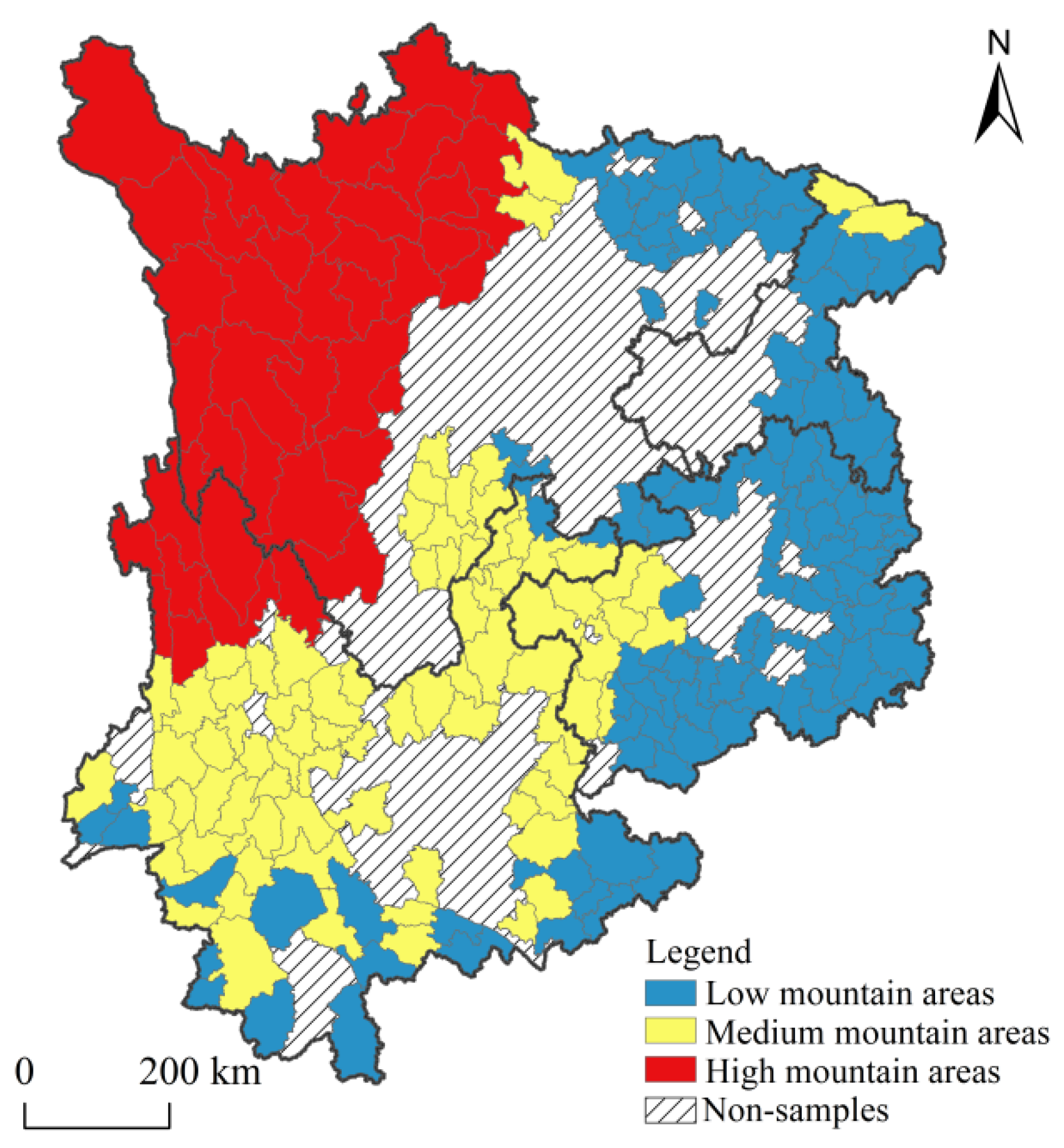
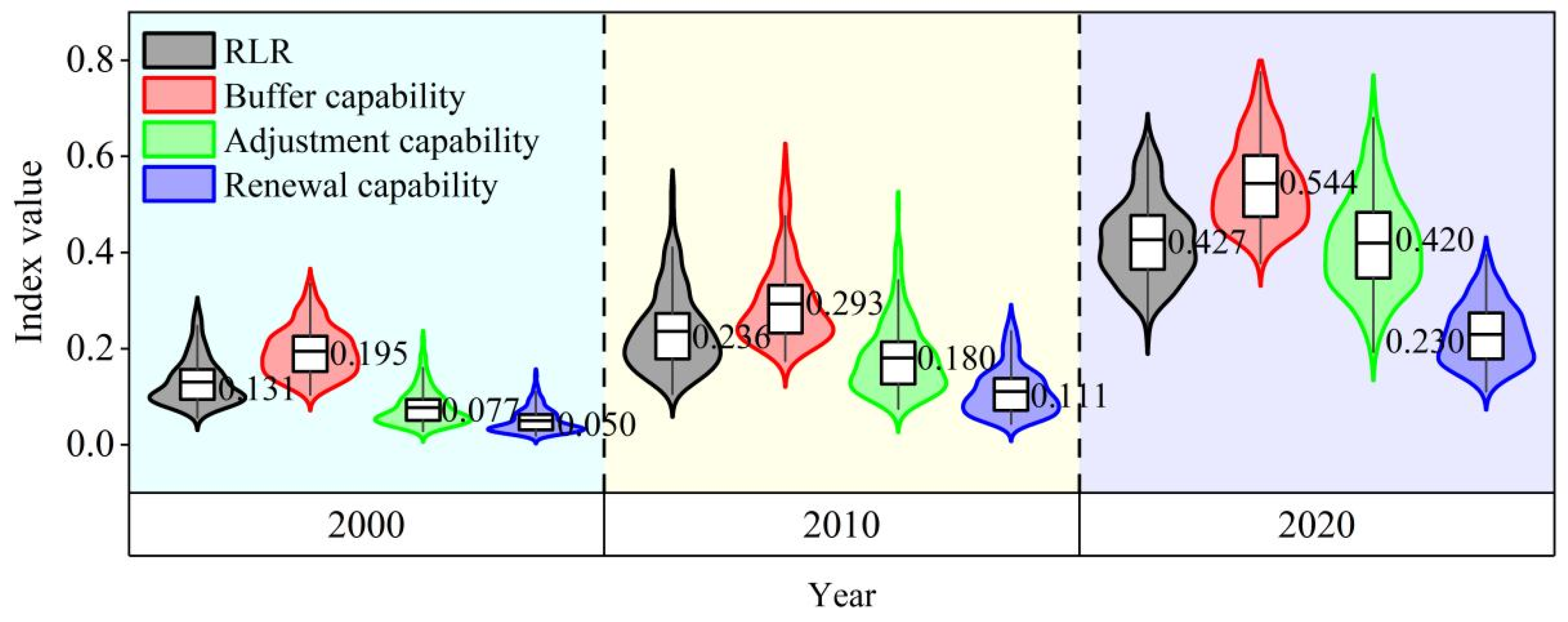
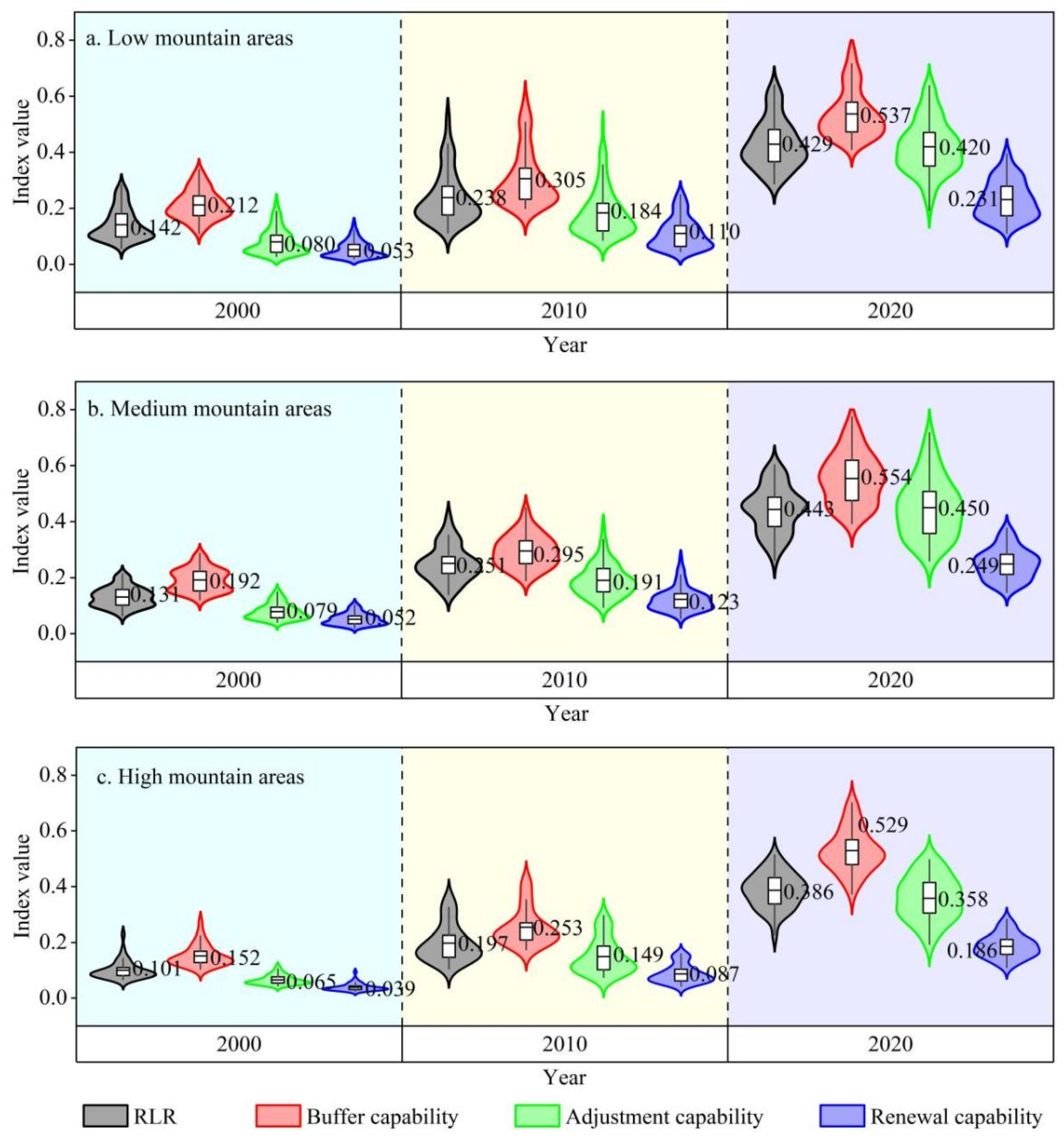
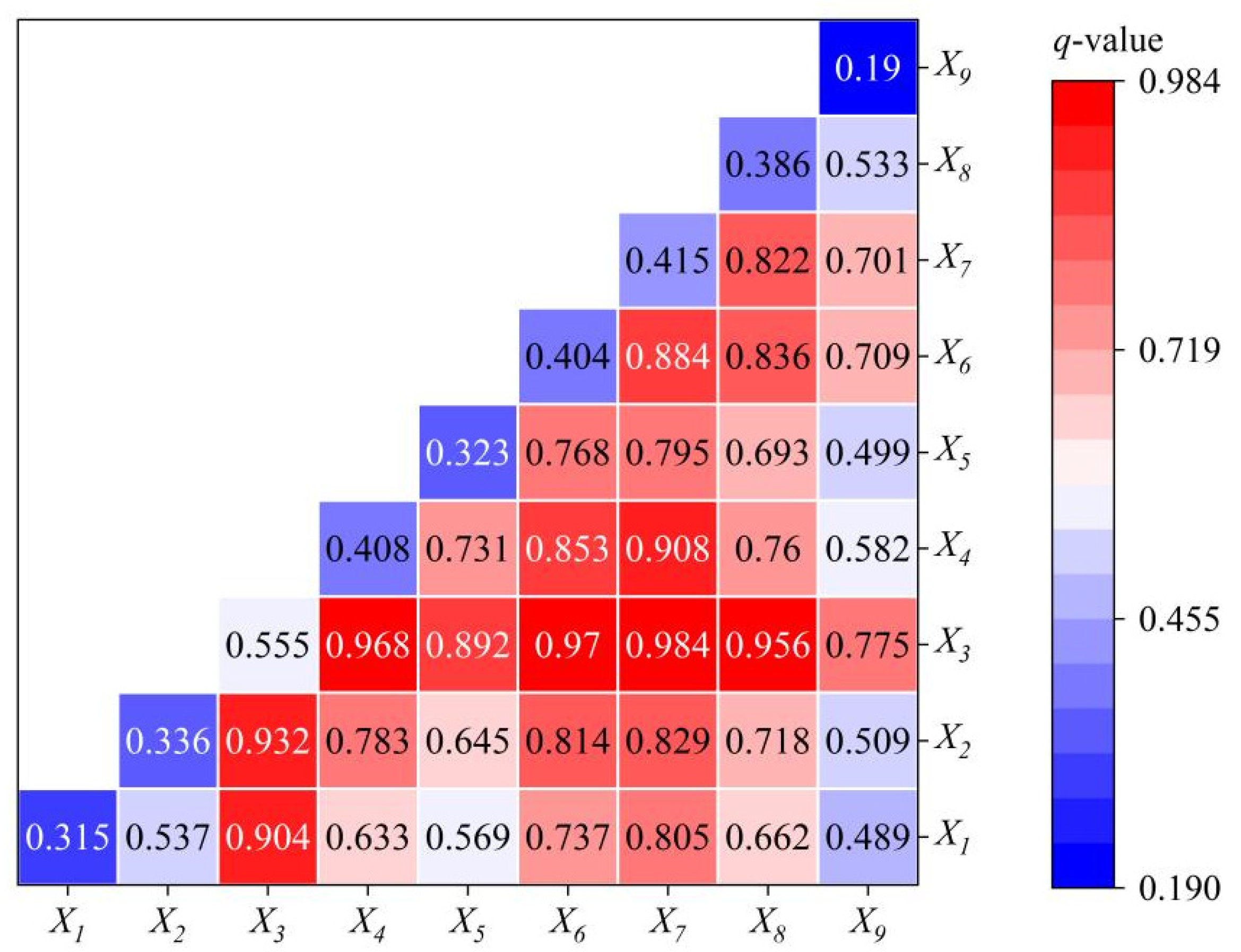
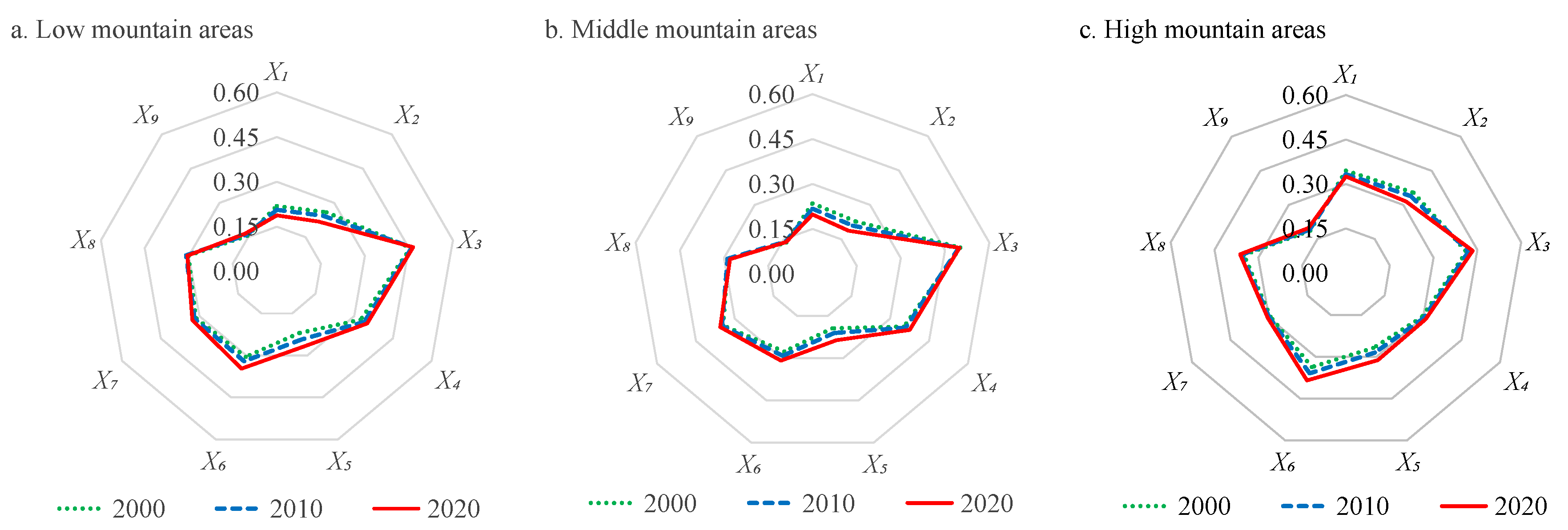
| Categories (Subcategories) | Indicators | Calculation Methods | Type | Weight | |
|---|---|---|---|---|---|
| Buffer capability | Natural capital | Cultivated land resources | Cultivated land area/rural population | + | 0.0423 |
| Water resources | Reservoir storage/total population | + | 0.0432 | ||
| Forest cover | statistical data | + | 0.0323 | ||
| Physical capital | Per capita housing area of rural residents | statistical data | + | 0.0372 | |
| Agricultural production tools | Total power of agricultural machinery/rural population | + | 0.0471 | ||
| Financial capital | Per capita disposable income of rural residents | statistical data | + | 0.0460 | |
| Per capita GDP | statistical data | + | 0.0485 | ||
| Social capital | Social security and employment investment | Fiscal expenditure on social security and employment/total population | + | 0.0327 | |
| Number of farmer professional cooperatives | statistical data | + | 0.0369 | ||
| Human capital | Proportion of rural employees | Rural employees/rural population | + | 0.0462 | |
| Coverage of rural subsistence allowances | Beneficiaries of rural subsistence allowances/rural population | − | 0.0382 | ||
| Adjustment capability | Farmland quality | Stable yield standard farmland area/effective irrigated area | + | 0.0503 | |
| Agricultural output | Gross output value of farming, forestry, animal husbandry and Fishery/rural population | + | 0.0510 | ||
| Rural electrification | Rural electricity consumption/rural population | + | 0.0393 | ||
| Agricultural infrastructure | Fixed asset investment in primary industry/rural population | + | 0.0451 | ||
| fiscal self-sufficiency rate | Fiscal revenue/fiscal expenditure | + | 0.0487 | ||
| Resource allocation | Fiscal expenditure/total population | + | 0.0514 | ||
| Renewal capability | Per capita education years of rural residents | statistical data | + | 0.0379 | |
| Urbanization rate | statistical data | + | 0.0486 | ||
| Agricultural modernization | Total power of agricultural machinery/sown area of crops | + | 0.0461 | ||
| Industrial upgrading | (Proportion of primary production × 1) + (proportion of secondary production × 2) + (proportion of tertiary production × 3) | + | 0.0442 | ||
| Green development | Total energy consumption/GDP | − | 0.0427 | ||
| Science and technology | Fiscal expenditure in science and technology/total population | + | 0.0441 | ||
| Influencing Factors | X1 | X2 | X3 | X4 | X5 | X6 | X7 | X8 | X9 |
|---|---|---|---|---|---|---|---|---|---|
| 2000 | −0.383 ** | −0.445 ** | 0.608 *** | 0.457 ** | 0.315 | 0.402 | 0.436 * | 0.432 *** | 0.268 |
| 2010 | −0.367 * | −0.416 * | 0.586 *** | 0.463 ** | 0.352 | 0.421 * | 0.450 ** | 0.457 *** | 0.276 |
| 2020 | −0.334 | −0.364 * | 0.592 ** | 0.470 ** | 0.404 * | 0.458 ** | 0.477 ** | 0.448 ** | 0.273 |
| Influencing Factors | X1 | X2 | X3 | X4 | X5 | X6 | X7 | X8 | X9 |
|---|---|---|---|---|---|---|---|---|---|
| 2000 | 0.347 * | 0.409 * | 0.564 *** | 0.390 ** | 0.255 | 0.341 | 0.393 * | 0.382 ** | 0.185 |
| 2010 | 0.331 * | 0.377 * | 0.547 *** | 0.403 ** | 0.287 | 0.365 * | 0.402 * | 0.393 ** | 0.194 |
| 2020 | 0.315 | 0.336 | 0.555 ** | 0.408 ** | 0.323 | 0.404 ** | 0.415 * | 0.386 * | 0.190 |
Disclaimer/Publisher’s Note: The statements, opinions and data contained in all publications are solely those of the individual author(s) and contributor(s) and not of MDPI and/or the editor(s). MDPI and/or the editor(s) disclaim responsibility for any injury to people or property resulting from any ideas, methods, instructions or products referred to in the content. |
© 2024 by the authors. Licensee MDPI, Basel, Switzerland. This article is an open access article distributed under the terms and conditions of the Creative Commons Attribution (CC BY) license (https://creativecommons.org/licenses/by/4.0/).
Share and Cite
Zhu, S.; Sun, J.; Wu, Y.; Lu, Q.; Ke, Y.; Xue, Z.; Zhu, G.; Xiao, Y. Vertical Spatial Differentiation and Influencing Factors of Rural Livelihood Resilience: Evidence from the Mountainous Areas of Southwest China. Agriculture 2024, 14, 1295. https://doi.org/10.3390/agriculture14081295
Zhu S, Sun J, Wu Y, Lu Q, Ke Y, Xue Z, Zhu G, Xiao Y. Vertical Spatial Differentiation and Influencing Factors of Rural Livelihood Resilience: Evidence from the Mountainous Areas of Southwest China. Agriculture. 2024; 14(8):1295. https://doi.org/10.3390/agriculture14081295
Chicago/Turabian StyleZhu, Siji, Jun Sun, Yingmei Wu, Qingping Lu, Yuechang Ke, Zhixuan Xue, Guifang Zhu, and Yiting Xiao. 2024. "Vertical Spatial Differentiation and Influencing Factors of Rural Livelihood Resilience: Evidence from the Mountainous Areas of Southwest China" Agriculture 14, no. 8: 1295. https://doi.org/10.3390/agriculture14081295




